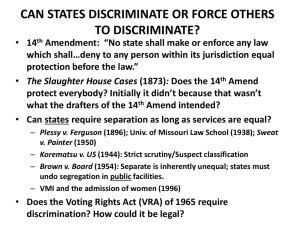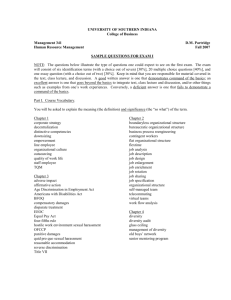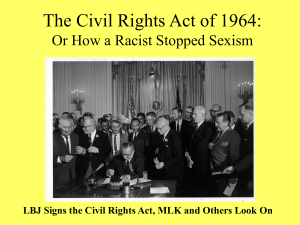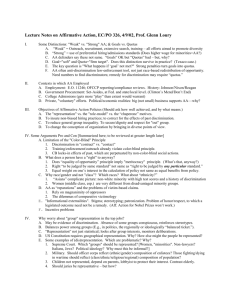Percent of population in recruiting area Percent of unemployment in
advertisement
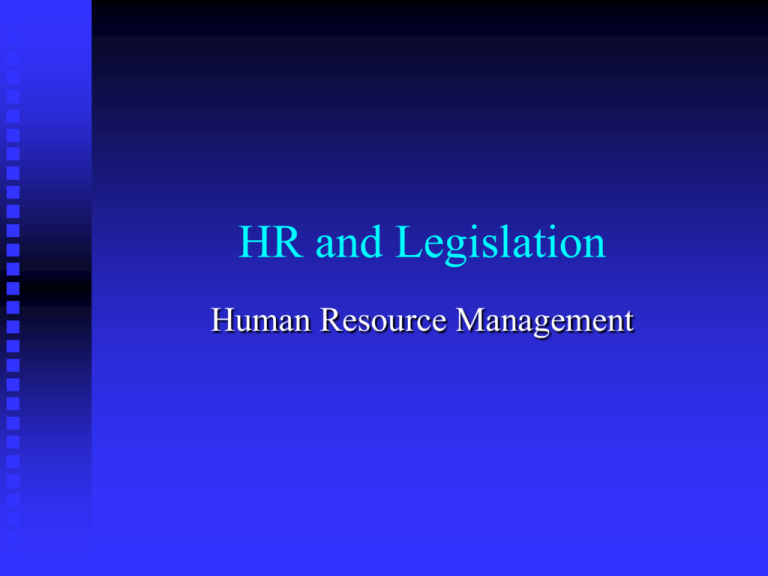
HR and Legislation Human Resource Management Legislation Affecting HR CRA 1964: Title VII Other CRAs ADEA Older Worker Protection Act FMLA EPA Executive Orders Rehabilitation Act of 1973 ADA Vietnam Era Veterans Readjustment Act Pregnancy Discrimination Act FLSA ERISA COBRA HIPAA OSHA WARN IRCA State and local statutes Civil Rights Act of 1964: What Is Discrimination? Disparate treatment “Discrimination is using race, color, religion, sex or national origin as a basis for treating people unequally” Civil Rights Act of 1964: What Is Discrimination? Illegal Disparate impact “Discrimination is any practice without business justification that has unequal consequences for people of different race, sex, religion, color or national origin without actually using any of those classifications as a basis for treating people unequally.” Civil Rights Act of 1964: Griggs v. Duke Power Duke Power used two neutral, “color-blind” criteria High school diploma Score on standardized ability test Resulted in unequal consequences for black and white workers But employees who did not pass the test or had a high school degree still performed adequately Civil Rights Act of 1964: Griggs v. Duke Power Title VII prohibits practices that create unequal (disparate) impact EXCEPT When business necessity or job relatedness provides justification for using them Civil Rights Act of 1964: EEOC Uniform Guidelines A “test” is anything that has an impact on the terms and conditions of employment How do you show job relatedness? “Test” must be valid Valid representation of job content Valid predictor of job performance “Tests” that are legally sound will make superior employment decisions Civil Rights Act of 1964: Sex Discrimination “Bona fide occupational qualification” Diaz v. Pan American Airways Male sued the airline for being denied employment as a flight attendance because of his gender Court found that BFOQ is justified only if The essence of business requires the exclusion All or substantially all members of one sex are unable to perform the job Civil Rights Act of 1964: Sexual Harassment Barnes v. Costle “But for her womanhood,” it wouldn’t have happened Meritor v. Vinson Identified two forms of sexual harassment Quid-pro-quo Hostile Environment “Unwelcome” is a key word in hostile environment cases Civil Rights Act of 1964: Sexual Harassment Management actions Written policy Sexual harassment is not tolerated Grievance without going through supervisor Training for managers to identify and take actions Affirmative Action Three reasons employers have affirmative action plans Government contractor of $10,000 or more in facilities of 50 or more employees Court ordered due to past discrimination Voluntary If AAP is due to government contract, OFCCP enforces What is Affirmative Action? Workforce analysis: Determine current workforce demographics Availability analysis: Determine the number of potential workers by demographic classification available in the workforce Based on eight factors Affirmative Action: Eight Factors Percent of population in recruiting area Percent of unemployment in recruiting area Percent of labor force in recruiting area Percent of available workers with required skills in specified area Percent of available workers with required skills in recruiting area Percent of workers promotable or transferable within the organization Estimate of existence of training institutions for required skills Estimate of training efforts organization is reasonably able to undertake What is Affirmative Action? Reconcile these by setting goals and timetables Flexible objectives that can be met in a realistic amount of time More like a budget than a mandate Plan action steps, implement and monitor progress Affirmative Action: Preferential Treatment McDonald v. Santa Fe Trail Corp.: Obligation not to discriminate against whites Weber v. Kaiser Aluminum & Chemical Corp.: Upheld because collaboration between union and employer Consensus of courts is that preferential treatment in involuntary plans (based on past discrimination) can be allowable Affirmative Action: Preferential Treatment Preferential treatment can be allowable if It is involuntarily adopted (due to past discrimination) It is remedial Does not exclude all non-minorities It is temporary It is formalized Americans with Disabilities Act Prohibits discrimination against “qualified individuals with disabilities” Has the skill, experience, education and other job-related requirements Can, with or without reasonable accommodation, perform the essential functions of the job Americans with Disabilities Act Individuals with a disability include those who Have a physical or mental impairment that substantially limits one or more major life activities Have a record of such an impairment Are regarded as having such an impairment Americans with Disabilities Act An employer must make reasonable accommodation unless it can be shown that accommodation would cause an undue hardship on the operations of the business Age Discrimination in Employment Act Protects all workers 40 or over Enforced by the EEOC Outlaws discrimination or mandatory retirement against those 40 or over Allows jury trials
